Teaching Communication
? In this module, we highlight those strategies that ensure that students learn new communication skills. So far this series of communication modules has highlighted:
- Identifying Communication
- Considering Sensory and Motor Factors
- Selecting Communication Targets and
- the Selection of AAC
This module is about teaching communication. We will highlight the evidence based practices for teaching students with moderate to severe disabilities (McDonnell , 1998); as foundation for thinking about how to teach student communication skills.
Teaching Communication Requires
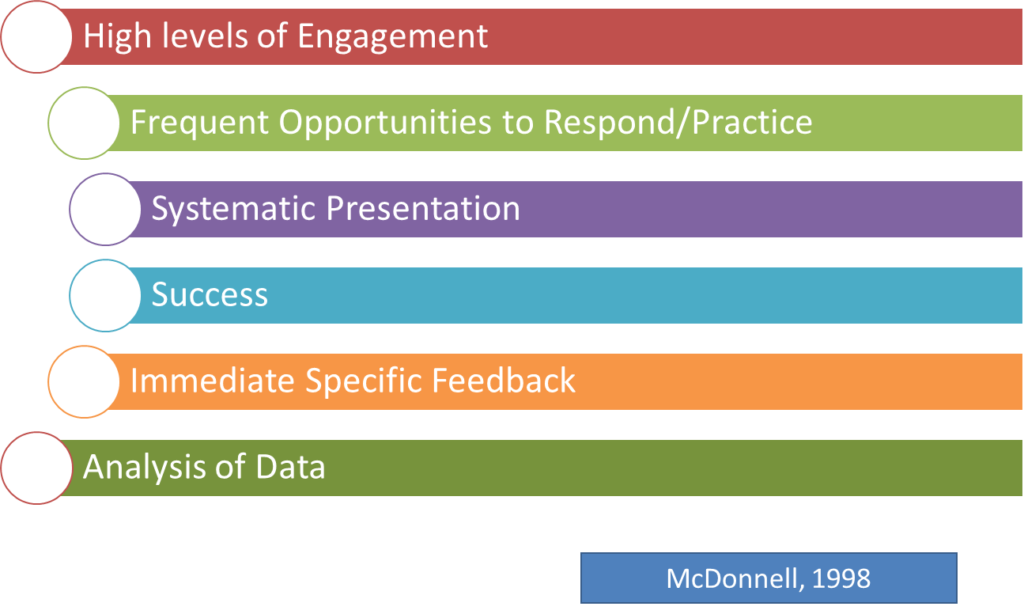
Promoting Achievement for students with significant cognitive disabilities requires the utilization of six evidence-based practices, as described by McDonnell.
These practices include :
- Ensuring high levels of student engagement or making sure students are interested in what they are learning and want to talk about it.
- Providing frequent opportunities for students to communicate.
- Using systematic procedures to teach communication. This has the advantage of allowing the team to problem solve when the student experiences difficulties.
- Facilitating success and making sure the student can demonstrate the skill by removing barriers and troubleshooting difficult steps or task sequences.
- Providing immediate and specific feedback about student response.
- Monitoring progress through the ongoing analysis of data. This is as essential as teaching itself for promoting achievement.
High Level of Engagement
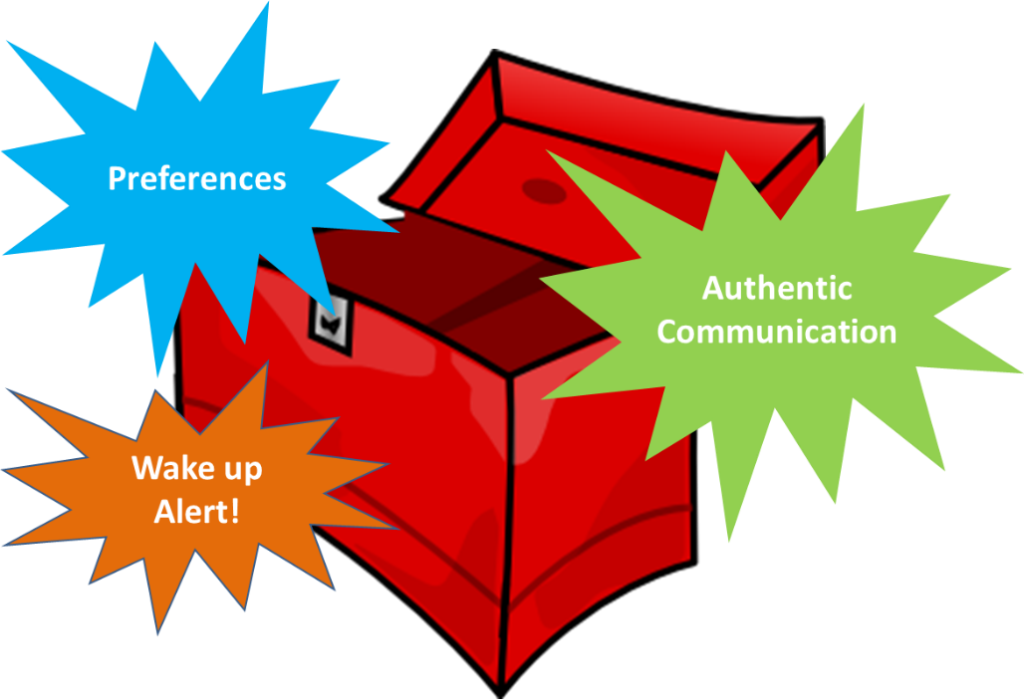
Establishing a high level of engagement for students with significant disabilities often requires a direct connection to their own experiences. In fact, we all learn better if there is a connection to something we already know and understand. In this section, we highlight the importance of determining a student’s preferences – things that they respond or alert when presented or available – by interviewing the family and the importance of authentic communication or extending the communicative exchange into a conversation.
Family, Friends, Favorites = Topics & Messages
To encourage high levels of engagement we must determine preferences or highly motivating activities, and as much as possible age-appropriate activities that might be engaging so as to keep the student interested, as well as provide conversation topics. We can do this by using family interviews to determine student preferences, special people, or possible conversation topics. These are things that the student’s behavior – alert, oriented indicate interest. A student whose most favorite thing is mom’s voice might engage with stories read aloud in mom’s voice or books/literature about mom. Finding out what is highly motivating for a student provided important leverage for communication. Similarly, student dislikes are also important.
Another way to encourage high levels of engagement is to convene a group of same-age peers to create an inventory of age-appropriate conversation topics to determine what similarly aged students enjoy. For example, what do nine-year-old boys/girls talk about – movies, games, music… What do middle school and high school students talk about? The student might not be interested in those things right now, but sometimes we can find age-appropriate activities that are topographically similar to the student’s preferred activity. In another example, if the student likes a preschool-age cartoon song… we look for age-appropriate music that is light and happy. Peer interviews are also important to help determine age-appropriate topics that will promote authentic conversations.
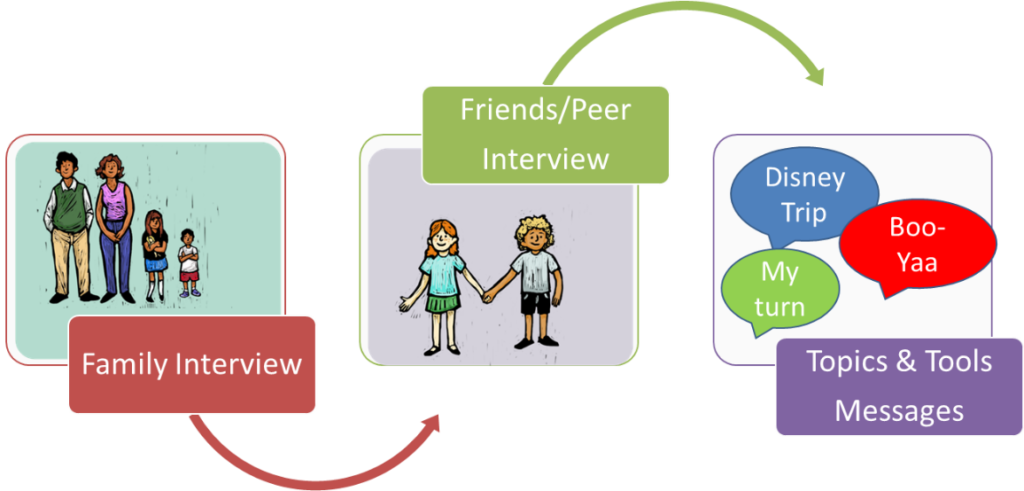
Finally, peers, family, and students themselves can help us identify which words, phrases, messages need to go on the devices the student uses. Peers can even help record those messages so that the voice output is age appropriate. Even pre-school students record messages on single button switch devices.
Engaging Academic Content
In addition to social topics, peer inventories can help identify important school curriculum topics. Engaging a student by finding out what kids of the same age/ are talking about as well as sampling the curriculum, will help the team leverage the student’s interest and increase opportunities for communication.
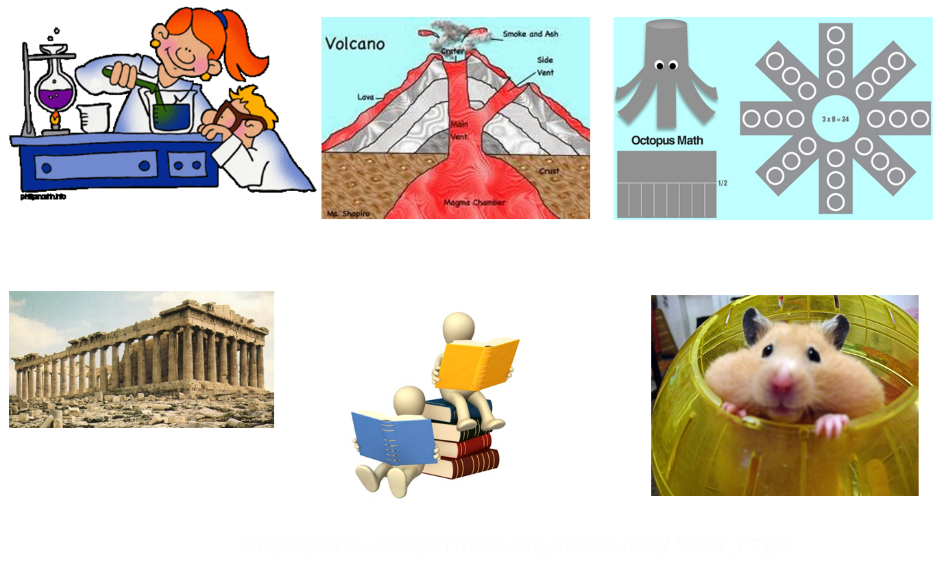
While the curriculum can be challenging in terms of student engagement, interesting activities that are connected to something the student knows and understands can be used to facilitate the student’s connection to the curriculum. For example, if they have a pet at home… the story about a pet hamster becomes more engaging. Science experiments are always good for engagement but even then…. a connection to something every day will increase the engagement level – a science experiment we can eat, a robotic car that uses a series of electrical circuits are two examples. The important thing to increase engagement is to find a way to connect the student to the content.
For more examples of curriculum, connections see the NCSC wiki.
Authentic Communication
Authentic communication takes the form of a conversation. Pictures, objects, or topic boards can be used to start or continue the conversation. This board stimulates conversation about a topic. In this case sports either high school or local college teams. Authentic communication provides opportunities for more than one exchange.
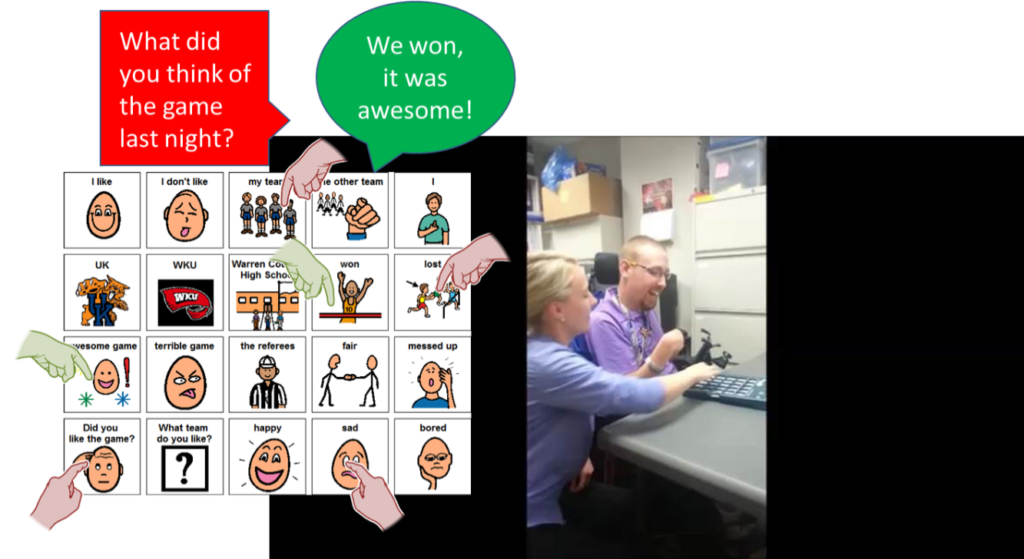
For example, the person asking the question highlighted in red points to the symbol on the board as s/he speaks “Did you like the game”; The responder (green) points to “Won” and “Awesome game”. The conversation continues with “My team lost” I’m Sad
It is important to note that the intention of talk boards such as these is that it is a true conversation and not a “find the UK symbol” type of task.
? Check your Knowledge
We can find out what motivates a student by doing which of the following:
a) Conducting a family interview
Hmm… look over the question and try again.
b) Conducting peer interviews
Well, yes, but check the information in the above section, and then try again.
c) Conduct a curriculum inventory
Um… not the only correct answer.
d) All of the above
Correct! We can find out what motivates a student by conducting a family interview, conducting peer interviews, and conducting a curriculum inventory.
Frequent Opportunities to Respond
In the next section, we discuss the importance of frequent opportunities to respond and creating opportunities for communicating.
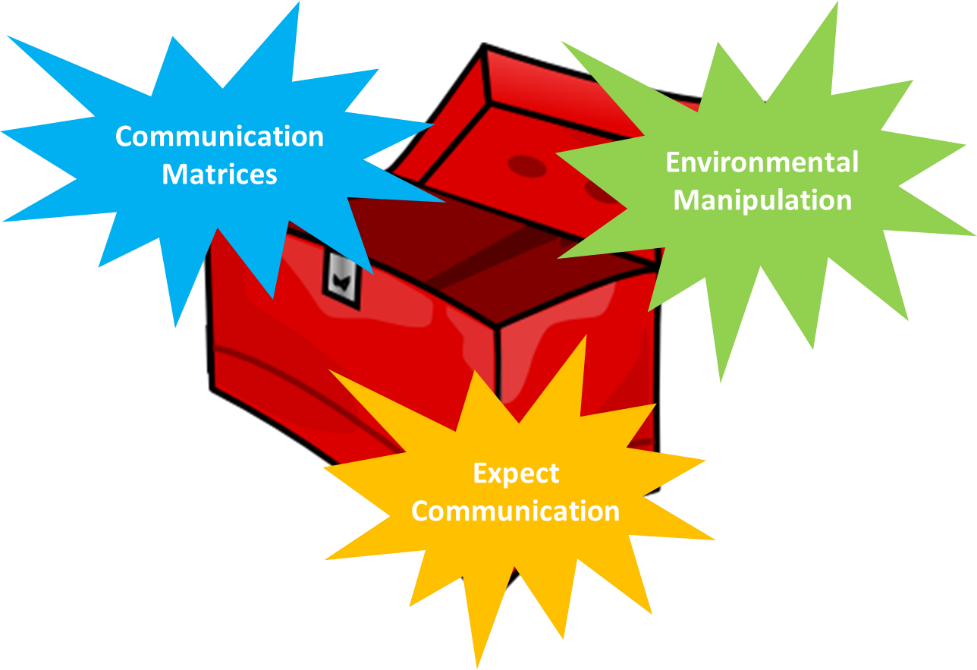
Topics under frequent opportunities to respond include Expecting Communication from all students and orienting all staff and students to use AAC when the student communicates. We assume all students communicate and have something to say. If we build our instruction on this assumption, then we will be looking for a variety of communication forms. Identifying the forms is essential to building skills.
Next, we use a matrix to help us embed basic communication targets – request, initiate, refuse into daily classroom routines, and target opportunities for practice using a variety of forms that are appropriate for the situation. For example, during lunch, the student may use a picture to request more milk, but in the class about science, he uses a device with more communication options on it.
Finally, in this section, we will discuss environmental manipulation to encourage communication.
National Joint Committee’s Communication Bill of Rights (NJC, 1992)
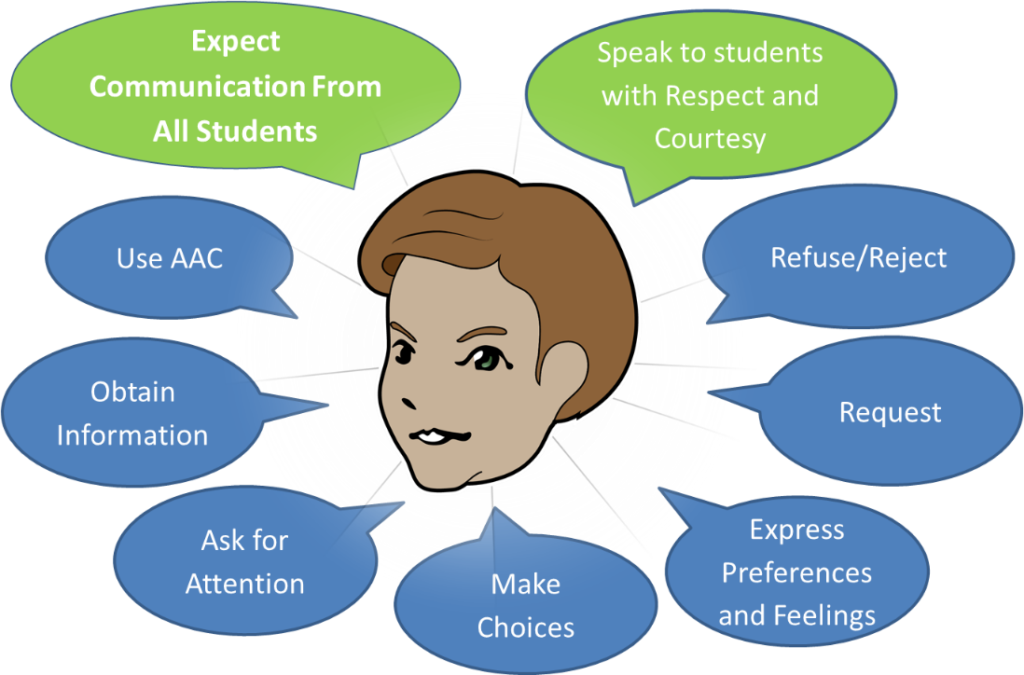
- Speak to students with respect and courtesy
- Students need a way to refuse or reject even if the refusal can’t be honored.
- Students need a way to request persons, objects, assistance
- Students need a way to express preferences and feelings
- Students need a way to make choices
- Students need a way to seek attention or ask for assistance
- Students need a way to obtain information – What’s next on the schedule? When’s lunch? When can I go home?
- Students need augmentative and alternative (AAC) communication so that their message is understood.
We must EXPECT communication from All students and therefore we must teach them the correct way to do these things whether they use AAC, signs, symbols, gestures, or facial expressions.
These communication intents can be found in the National Joint Committee’s Communication Bill of Rights. These can be posted in the classroom as a way to orient staff and students that communication is important . Embedding these ‘rights’ may be a way to remind staff to create opportunities for communication. At a minimum, students who do not use oral speech, need a way to seek or ask for attention. This can take the form of a single switch with a recorded message – “Help please”. Students need communication forms (AAC, facial expressions, body language, pictures, etc.) to request/refuse, to obtain information, to seek attention, to choose from options, as well as express preferences and feelings. Using these ideas as classroom expectations could increase communication simply by attending to the communication needs in a systematic way.
Determine opportunities to practice
Using a communication target activity matrix can assist the team in determining which targets can be taught and which mode will be selected based on the type of target.
For example, at lunchtime – the student may use pictures to request more of something or indicate that the next bite should be _______. Asking a question during math class might require a different communicative form. Pictures but a more complex array. The idea here is to determine if indeed there are enough opportunities to practice the skill. It also cues the teacher/SLP to think about how the student will communicate best during which activities – collect data, or how to phase in new messages.
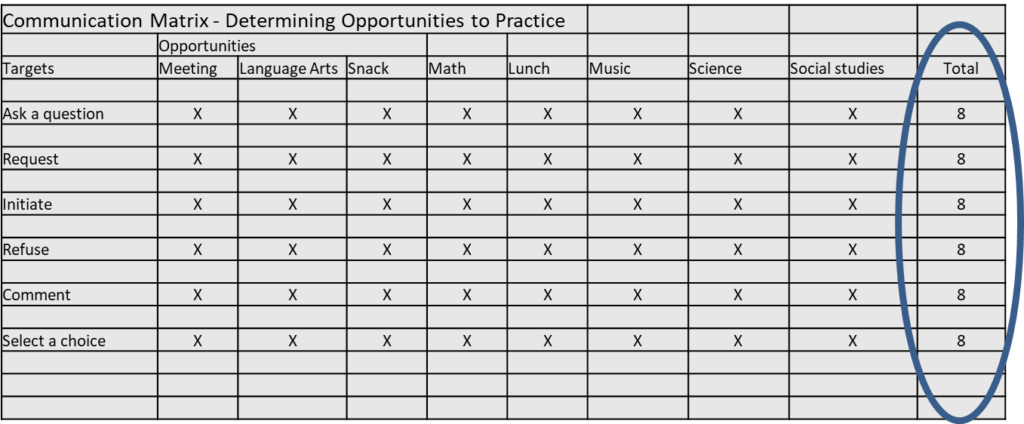
Create opportunities – Environmental Manipulation
Creating opportunities may mean putting preferred items out of reach, ‘forgetting’ to provide a preferred item or an item needed to accomplish a task, have a turn, or inserting a step that requires the student to communicate – such as a switch message on the door that says – May I take a walk? In this video clip, a voice output switch is placed next to the door. Alex wants to go for a walk. His teacher directs him to use the switch by the door to ask for a walk. The teacher has manipulated the environment – She identified a highly preferred activity for this student, manipulates the environment by placing a switch close to the access point. She acknowledges his use of other forms to request to go for a walk and directs him to use the switch to make the request. Finally, she provides detailed feedback and honors Alex’s request to go for a walk.
? Check your Knowledge
To increase communication output from any student, we must
a) Create opportunities to respond
Well yes, but is this the only correct answer?
b) Manipulate the environment
Umm… is there a better answer?
c) Expect communication
Yes, that could be correct, but is it the only correct answer?
d) All of the above
Correct! All of these are ways to increase communication output from any student.
Systematic Presentation
The third evidence-based practice to increase the acquisition of targets is systematic presentation. The important thing is that EVERYONE uses the same procedures, under precise conditions, and provides the least intrusive prompt needed by the student can demonstrate. Using these procedures helps the student understand and respond correctly. It also involves the use of procedures like simultaneous prompting – where the teacher models the correct response for the student before the student has a chance to make an error, until the student begins to imitate independently.

Aided Language Stimulation is a systematic procedure often used by teachers to MODEL the use of pictures, or voice output devices by actually using the device while communicating
Four items in systematic presentation that are important for teaching communication include prompting in the form of modeling appropriate communication, providing ample wait time for the student to provide a response, and acknowledge, respond-as-if meaningful, and honor as appropriate. For example: Oh, I understand, you said, “more please”. That is acknowledging and responding as if meaningful. “I have some more. Here you go.” That is honoring. Of course, sometimes there is no more. When that happens, one might say “Oh you want more,” and then show there is no more, and say “I’m sorry the bag is empty. No more Cheetos.”
The last systematic strategy for teaching communication to be discussed is Aided Language Stimulation. When using this strategy the communication partner uses the student’s communication system while speaking to the student. This provides a model for the student on how to use the system, demonstrates that the system is an acceptable form of communication for anyone, and facilitates authentic communication as shown earlier in this module.
Improving Communication
The first and most important three steps to improving communication is to acknowledge any behavior as communicative, “Oh that smile means you like it”… respond as if the behavior was meaningful.. “would you like MORE?”, WAIT but tell the person what to do … use that smile to tell me more or…here is a card that has a picture of more… model how to say more… smile, sign, card…. Honor the request for more… “oh can I help you with that” If the behavior is ‘inappropriate’ sitting on the floor – oh… you are sitting on the floor, sitting on the floor means you are tired and need to rest, let’s find a chair to rest”. When you are ready to go… use your ________ to tell me.
Acknowledge and Respond
In this video clip, Simon’s teacher acknowledges and responds as if meaningful, and honors a request for more “messy”. This teacher may not really be sure that Simon is asking for “more messy” she is ‘reading’ his actions, affect, and responding as if he does indeed want “more messy”, and honoring by providing more ‘messy’.
Systematic Presentation
Systematic presentation is an evidence-based practice in teaching students with moderate to severe disabilities. We start by identifying a prompt that the student understands and can perform. In this case, the teacher uses a single switch, voice output device to say “Good Morning, I’m using my button to use my say “Good Morning”. The teacher provides a task direction “Can you use your button to say “Good Morning” and waits for the student to respond. If the student responds – teacher acknowledges “yes, you said good morning” ; OR if the student continues to wait – the teacher models again with “his/her” switch and points to the student’s switch and reminds them – Your switch says Good Morning – can you show me? Prompting can continue to a physical prompt if needed. After a few correct independent, responses – the teacher may say – “Good Morning ____________________” to ensure that the response is indeed under the control. This systematic presentation could be flipped – meaning the Task Direction could be provided first and then the prompt/demonstration of the skill.

Aided Language Stimulation
Another teaching strategy for building communication is Aided Language Stimulation. Just like authentic communication, Aided Language Stimulation requires the communication partner (teacher, parent, or peer ) to use the device – in this slide, the partner will point to the pictures as s/he asks a question or makes a comment. It might go something like this.
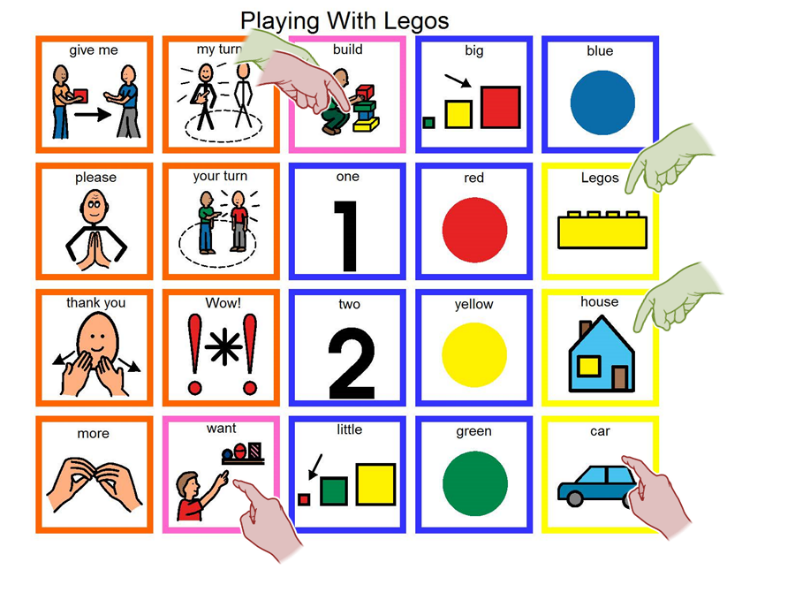
“ Do you want to build a house with Legos?”
“ I want to build a car.”
? Check your Knowledge
Aided language stimulation helps the student by
a) Providing extensive modeling
Yes, modeling is important – but is this the only correct answer? Try again
b) Using the same communication system
Well, yes, using the same communication system is important for consistency. However, is that the only reason aided language stimulation helps the student?
c) A and B
Correct, aided language stimulation helps the student by providing extensive modeling, and using the same communication system.
d) None of the above
Incorrect. Re-read the question and try again.
Ensure Communication Success

Ensuring communication success involves
- ensuring that communicating is easy for the student
- acknowledging and responding to a variety of communication forms
- modeling the use of new communication forms – AAC, signs, words, pictures exchanges; and
- ensuring accessibility.
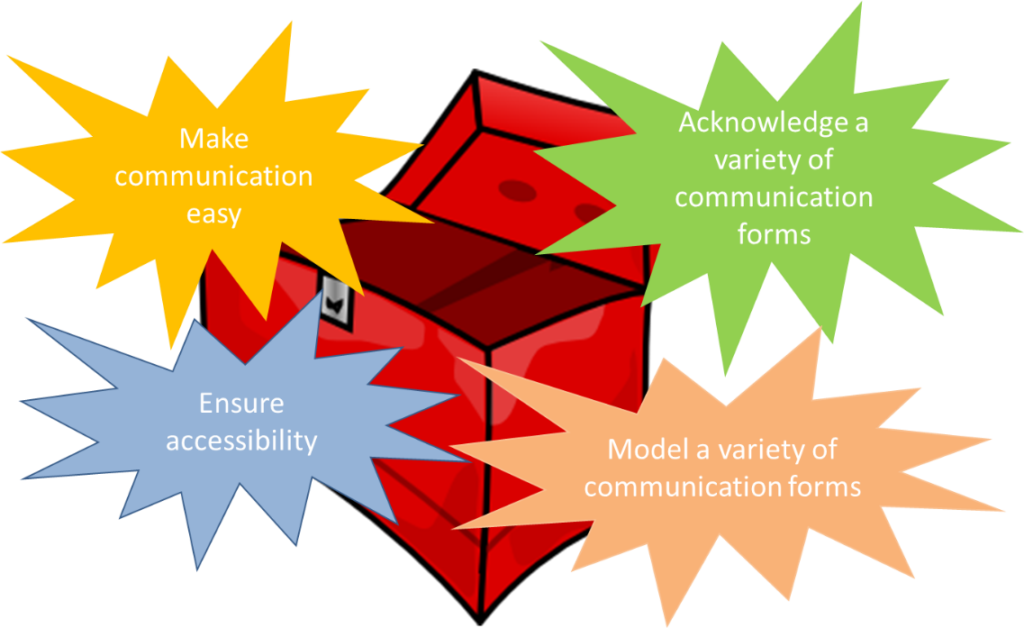
Make it easy. Using a device is hard work. Troubleshoot hearing, vision, and motor challenges.
Since a device is hard, use it for really important messages, and then accept other communication forms, such as eye gaze or facial expressions to support the message as well. Acknowledge all communication forms and remember that the strategies of acknowledging, responding as if meaningful, and honoring are all ways to shape communication forms.
Make it OK and even “cool” to use a device by USING the device yourself to model communication. Remember, students must hear words used thousands of times before they use them competently. Strategies such as Aided Language Stimulation show the student how to use AAC and make it “cool” when peers and teachers can use it as well.
As we stated earlier, using a device is hard, so, make it accessible. If a student has difficulty looking left to right, put AAC options in a vertical column for a student to more easily view.
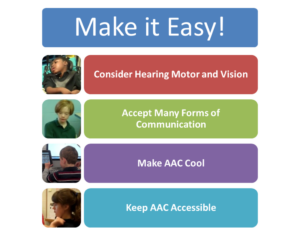
Consider Hearing Motor and Vision
In this clip, the teacher is providing a variety of input to accommodate vision and hearing challenges. She is using words, touch, smell to engage the student in the lesson.
Accept Many Forms of Communication
In this clip, Steve uses LOTS of communication to request the snack.
Make AAC Cool
When peers use the device it becomes “cool”
Keep AAC Accessible
In this clip, notice how the teacher modifies the display after she realizes that the student wants a bite of yogurt but she can’t reach the switch representation for a bite.
? Check your Knowledge
We can increase student success in communication by making it easy.
True
Correct! Making communication easy is the best way to increase student success.
False
Hmmm… re-read the question and try again.
Immediate and Specific Feedback
Next, we will explore Immediate and Specific Feedback.
Acknowledge attempts with specific verbal praise, even if they aren’t perfect and shape them toward a more refined production. “Oh, Susan, you used your device to tell me what you want. Great job! That’s really hard work.”
If the communication is a request, try to honor it if at all possible. “Oh, you told me you want my help. Ok, I can help you”.
If you can’t honor a request, then at least acknowledge it. ”Oh you told me you wanted my help. I understand you. I can help you with that in a few minutes.”

Specific Feedback.
Remember Alex, we saw him earlier when we were discussing manipulating the environment. This time listen to how the teacher provides specific feedback on Alex’s communication attempts in order to shape a more sophisticated form of request.
Well, this is embarrassing. The link to the video is currently offline. We will get back to you soon.
? Check your Knowledge
Telling a student they did a ‘good job’ is sufficient for reinforcing new behavior.
True
Re-read the question and try again.
False
Correct. A student needs specific feedback to reinforce new behavior.
Analysis of Data
The final section in this teaching module is the use and analysis of data…

Charting student performance data will help the team make important decisions about student progress and identify sources of problems.
Chart the Data

Start simple and use a counter to tally the number of communications that a particular student demonstrates in a defined time period. How many communication events occurred in the first thirty minutes? Charting the data collected on a specific target and then conducting an analysis will help the team determine if the strategy is working. It may also help point out that a student is already demonstrating a skill sufficiently.
We will discuss collecting and managing data in a later topic in the Communication Tool kit series.
Topic 5: Teaching Communication Summary
Promoting Achievement for students with significant cognitive disabilities requires the consideration of six evidence-based practices.
These practices include :
- Ensuring high levels of student engagement or making sure students are interested in what they are learning and want to talk about it.
- Frequent opportunities for students to communicate
- Communication skills are taught using systematic procedures so that the team can problem-solve when the student experiences difficulties.
- Success is about making sure the student can demonstrate the skill by removing barriers and troubleshooting difficult steps or task sequences.
- Students need immediate and specific feedback about their response. “Great job, you told me ______”… or “uh oh, you forgot to”… in either case the feedback is not just “great job” but very specific in the feedback.
- Finally, the ongoing analysis of student performance data. Monitoring progress through the ongoing analysis of data is as essential as teaching itself for promoting achievement.
References
McDonnell, J. (1998). Instruction for students with severe disabilities in general education settings. Education and Training in Mental Retardation and Developmental Disabilities, 33, 199-215.
Bowen, C. (2011, November). Supporting Speech and Language Progress in Children with CAS or sCAS. Retrieved from http://speech-languagetherapy.com/index.php?option=com_content&view=article&id=42:support&catid=11:admin&Itemid=108
Ostrosky, M.M. and Kaiser, A.P. (1991). Preschool classroom environments that promote communication. Teaching Exceptional Children, Summer, 6-10.
Microsoft Clip Art PowerPoint 2011
Wolery, M., Bailey, D., Sugai, G. (1988). Teaching students with moderate and severe disabilities. Boston: Allyn & Bacon.
This module has been about teaching communication using a total communication approach. The next module is about embedding communication into academic content to promote language development.
